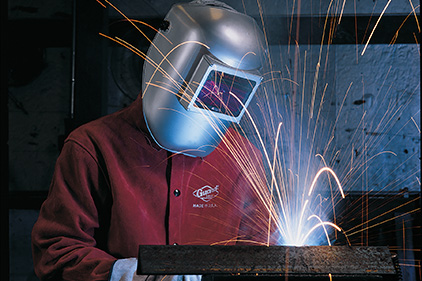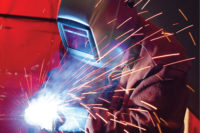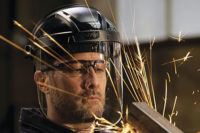Providing welders with the proper personal protective equipment for the eyes, face and head is crucial to avoiding injuries ranging from minor bumps, burns and temporary vision loss to devastating head injuries and permanent blindness. This article looks at the various aspects of welding safety that, once considered, can enhance the protection, comfort and productivity of your workforce.
Primary eye protection is a must
Welders experience more eye injuries than nearly any other occupation group, averaging roughly 1,800 per year. The first line of defense in protecting welders’ eyes is primary eye protection in the form of either safety spectacles or goggles. According to the American National Standards Institute Z87.1-2010 standard for eye and face protection, such safety eyewear must be worn under welding helmets in all instances. While clear lenses are commonly acceptable, in higher intensity applications consider eyewear with specialized lens filters that employ IR-absorbing or heat-reflecting dyes to minimize the heat load to the eyes and face. No matter which style you select, be sure all components (i.e. frames and lenses) are marked “Z87” to ensure it meets ANSI requirements.
Welding helmet innovations
Welding helmets are the first defense in protecting eyes from harmful arc flash. The helmet’s filter lens should shade the eyes at a level corresponding to that of the arc radiation generated by the application. Welding helmets generally feature either passive lenses or auto-darkening filter (ADF) lenses. Passive helmets feature a fixed shade glass or polycarbonate lens that the welder looks through to conduct work. In ADF helmets, the filter lens automatically switches from a light state to a dark state in response to a change in light intensity. The ADF lens improves safety, productivity and quality welds because it is left in place for the duration of work. ADF lenses also can eliminate neck injuries that can come from using passive lenses, which cause users to repeatedly nod their helmet down into place.
Welding helmets also shield the eyes and face from intense heat, flying debris, weld spatter and slag, and sparks and flame. They are durable and may provide ample protection against basic hazards for many years. However, workers outfitted in outdated welding helmets are at a significant disadvantage when it comes to overall performance. Recent innovations in materials and design significantly reduce weight and bulk, while advances in comfort and fit reduce fatigue and soreness. By selecting modern welding helmets that are lightweight and streamlined, workers are able to focus on the task at hand rather than interruptions caused by fatigue or making adjustments to ill-fitting PPE.
Special considerations
In many applications, welding helmets are worn in combination with hard hats. In this case, a mounting system is used to attach the face protection to the hard hat. There are many styles of mounting systems, and key considerations for their selection should include frequency of use, ease of use, durability, flexibility and compatibility with different products. For high-frequency situations, look for attachment systems that are fully adjustable to fit any style of hard hat and have a brim tab design that allows the faceshield or welding helmet to fit securely onto the hard hat. For long-term secure situations, look for attachment components that are pre-installed and permanently fixed onto the hard hat for ease of use.
Because of the weight that a faceshield or welding helmet adds to the hard hat, it is especially important to choose a properly-fitting hat with a well-balanced suspension system. Suspensions typically come in 4-point, 6-point and 8-point varieties. The greater the number of suspension points, the more balanced the hat will feel, delivering long-term comfort. Furthermore, a larger number of suspension points better disperses energy upon impact, reducing the impact and resulting trauma to the wearer.
Options in welding PPE are vast. When selecting combined head and face protection, look for a supplier that can help your company develop and implement a comprehensive head and face protection program. Free consultation, hazard analysis and selection criteria development are some of the ways a supplier can help your organization make the best possible PPE buying decision.
Investing in new welding PPE
As widespread as welding activities are, in some cases they are performed infrequently. As a result, it is common for advances in personal welding safety equipment to be overlooked. In fact, it is not uncommon to see welding PPE that was manufactured more than a decade ago still in use today. Modern helmets offer significant advantages over their dated counterparts in protection, comfort, convenience and style. These advances not only improve individuals’ safety on the job, but also help attract younger talent to an aging welding workforce.
Protect everyone exposed to the arc
It is important to remember that individuals working near the welding area are also at risk of eye injury. Everyone within 20 feet of the welding application, or passing by it, faces indirect exposure to radiant energy and spatter and should be outfitted with safety eyewear at a minimum. For those working either directly or indirectly in the welding process, the use of safety eyewear with clear lenses is usually acceptable. For higher intensity applications, consider primary eyewear with specialized lens filters that employ IR-absorbing dyes for added protection.
Given the inherent risks involved in welding operations, it is important to assess PPE on an annual basis and determine whether the workforce is outfitted in the safest, most effective equipment. By understanding the advantages offered by the latest innovations, you can make selections that not only maximize workers’ protection but also their comfort. Protective equipment should be rated to meet the rigors of the specific job application, including hazard type, amount of coverage required, heat rating and ease of use when worn with other PPE. By providing workers with the optimum PPE and encouraging proper usage through a supportive safety culture, employers can reduce injuries in the workplace — and provide a healthy boost to productivity and the bottom line.



